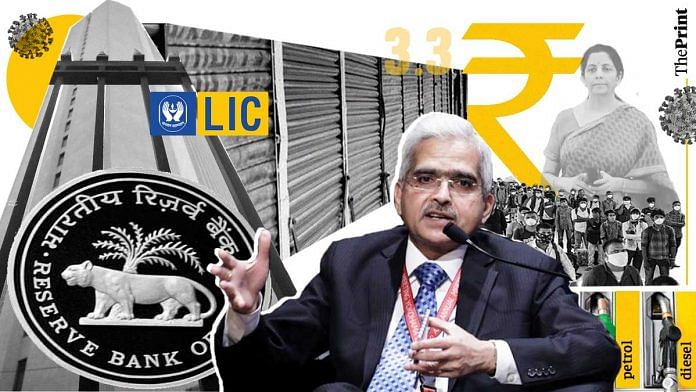The Reserve Bank of India has presented a worrying picture of the state of government finances in its annual report released earlier this week.
The government’s fiscal position was already fragile in 2019-20, and is expected to deteriorate further in the current year amid the Covid-19 outbreak and disruption in economic activity due to the lockdown.
Now, the government needs to re-assess its revenue and fiscal situation for the current year.
The fiscal situation
Due to the economic slowdown in 2019-20, the fiscal situation was already getting difficult. The fiscal deficit was estimated to be 3.3 per cent of GDP. At the time of presenting the budget in February, the finance minister had announced a deviation of the fiscal deficit target from the budgetary estimate.
Section 4(3) of the FRBM Act allows a deviation of fiscal deficit target to the extent of half-a-per cent of GDP under certain circumstances. These include structural reforms with unanticipated fiscal implications. The finance minister said the government was deviating from the fiscal deficit roadmap for bringing in structural reforms. The revised estimate for fiscal deficit for 2019-20 was 3.8 per cent of GDP.
Weak growth led to a shortfall in revenue. Controller General of Accounts (CGA) data shows that the fiscal deficit for 2019-20 came in at 4.6 per cent of GDP. The 1.3 per cent slippage from the budgetary target was primarily on account of a shortfall in tax revenue. Economic growth had slowed to 4.2 per cent in 2019-20.
For the current year, the fiscal deficit was pegged at 3.5 per cent of GDP when the Union Budget was announced in February 2020. This was prior to the spread of Covid-19 in India. This was also a deviation from the fiscal deficit glidepath envisaged in the FRBM Act, which mandates the fiscal deficit to be 3 per cent of GDP by 31 March 2021.
Almost immediately after that, the pandemic hit India and the country went into lockdown. This meant both a sharp decline in economic activity, which will reduce taxes, and an increase in government expenditure for relief measures.
In this backdrop, achieving a 3.5 per cent fiscal deficit target is not feasible. The government has already announced an additional borrowing requirement of Rs 4 lakh crore, taking the total borrowings for 2020-21 to Rs 12 lakh crore. This increased borrowing alone implies that the fiscal deficit would be around 5.3 per cent of GDP.
This figure is based on the assumption of a 10 per cent nominal GDP growth which is highly unlikely. Given that GDP will contract, a lower denominator would mean a higher fiscal deficit ratio.
Also read: This recession is different & India can bounce back much faster than in the past
Assumptions need a re-look
The assumptions on which the fiscal deficit target for 2020-21 was fixed need a relook. One of the key targets was the Rs 2.1 lakh crore receipts from disinvestment — almost four times what was realised in 2019-20. One of the elements of the disinvestment plan is the initial public offering of the Life Insurance Corporation of India, through which the government plans to raise Rs 90,000 crore. This seems challenging in the current scenario, even though the process to launch the IPO has begun.
In addition, tax revenues will be lower. The first quarter numbers already show a sharp contraction in revenues. The government has hiked excise duty on petrol and diesel to raise additional revenues.
Expenditure compression measures, such as the 18-month freeze on additional dearness allowance for civil servants, could create some fiscal space. Nevertheless, it is certain that there will be a major slippage from the budgeted fiscal deficit target.
Higher deficit implies that the government’s debt-to-GDP ratio would rise. The FRBM Act mandates that the central government’s debt-to-GDP ratio should not exceed 40 per cent of GDP by 2024-25 and the central and state governments’ combined ratio should not exceed 60 per cent. In the current year, the debt-to-GDP ratio is expected to rise by somewhere between 10 to 12 per cent.
Higher debt burden will constrain government’s ability to do additional spending and support economic revival. The FRBM targets will need to be postponed.
Also read: The 3 big unknowns that have forced Nirmala Sitharaman to be prudent with economic package
A worldwide problem
Since the pandemic was an extraordinary shock, governments around the world are suffering similar shocks to their government finances. Fiscal deficits are rising across the board in emerging markets. Countries like Brazil, Turkey, South Africa and Colombia were already challenged with debt issues before Covid-19, and now that fiscal deficits and debt dynamics will take a turn for the worse, new problems will arise.
For example, it is expected that the economic and fiscal challenges due to Covid will raise potential debt sustainability issues for Brazil, imminent balance of payments challenges for Turkey, and downward ratings pressure for Colombia and South Africa.
In India, the next round of stimulus package is expected to be announced only when the Covid-19 pandemic shows some signs of subsiding. At the same time, the government should make a realistic assessment of its revenue and expenditure targets for the current year.
These will, of course, need to be updated as the situation changes. But greater transparency at every point will give greater confidence in the Indian government bond market.
Ila Patnaik is an economist and a professor at National Institute of Public Finance and Policy.
Radhika Pandey is a consultant at NIPFP.
Views are personal.
Also read: Why India has increased economic freedoms in response to Covid, unlike Europe & US




Act of God it may well be, but it requires outstanding human talent to deal with it.
Outstanding – ha.